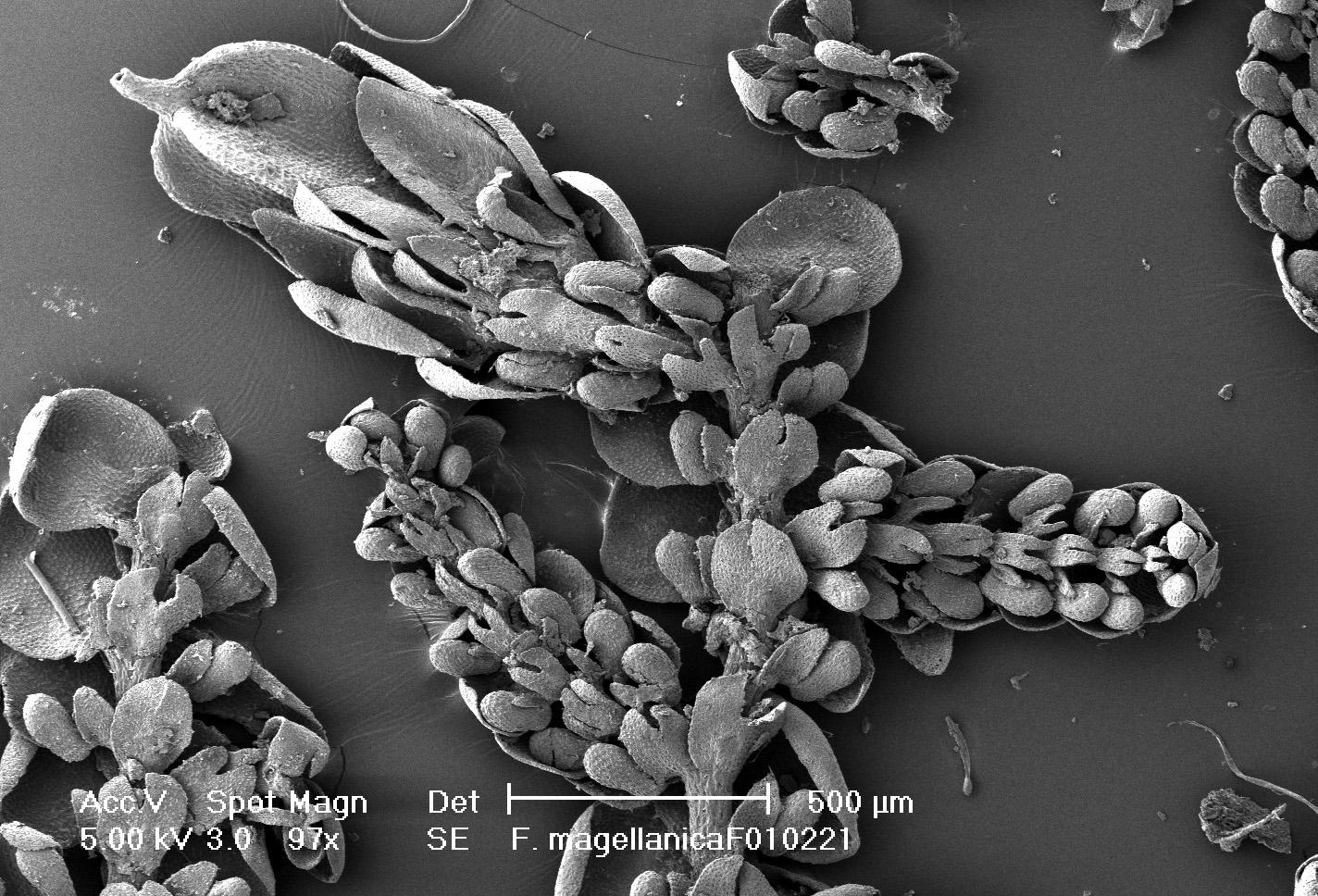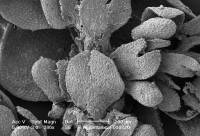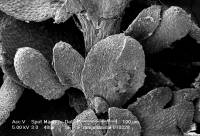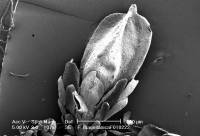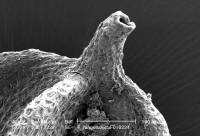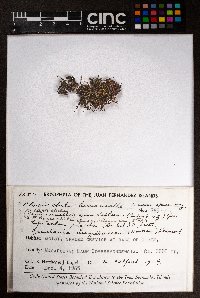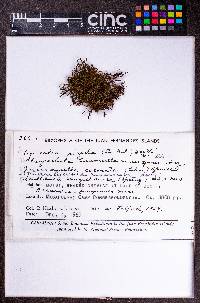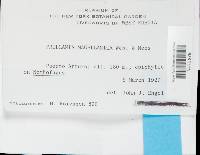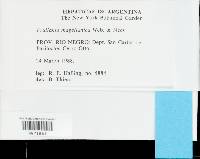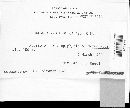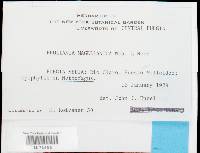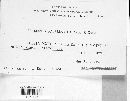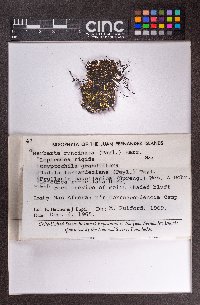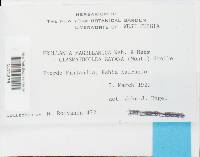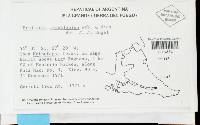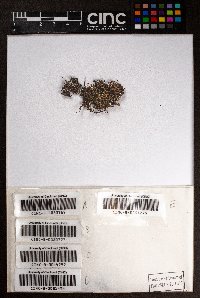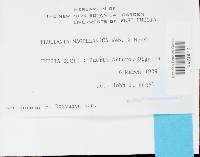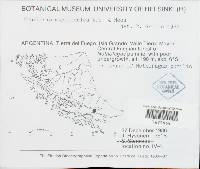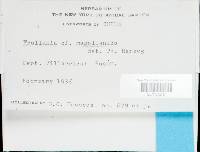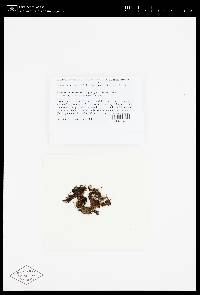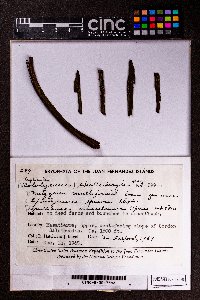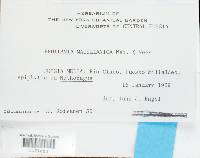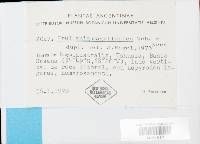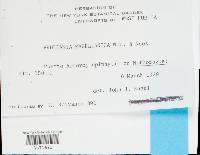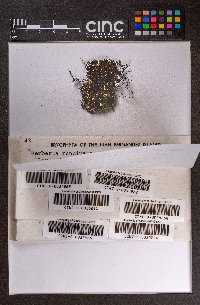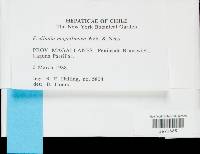
Consortium of Bryophyte Herbaria
- building a Consortium of Bryophytes and Lichens as keystones of cryptobiotic communities -
|
|
|
|
Family: Frullaniaceae
[Frullania fertilis var. fertilis autonym, moreFrullania magellanica subsp. magellanica , Frullania magellanica var. magellanica autonym, Frullania tristaniana S.W. Arnell] |
Detailed description: Plants typically medium in size and forming dark red-brown patches. Branching often regularly pinnate, occasionally bipinnate. First branch underleaf (BUL1) always with three distinct segments, the ventral lamina divided for ca. ⅓ its length into two lobes (a larger abaxial lobe and a slightly smaller adaxial lobe) + 1 dorsal saccate lobe. First branch leaf (BL1) with three distinct segments and features ±similar characteristic of those of the main stem. Stem leaves of main branch suborbicular to broadly oval, to 520µm long × 490µm wide; often with strongly incurved distal margins; lobe apices usually broadly rounded or occasionally narrowly rounded to subacute. Lobules remote from the stem and at angles of 2545 (50)° with the stem so that lobules are tilted outwards lobules; cylindrically pitcher-shaped, and medium in size (lobuli area rarely obscuring more than ⅓× the exposed area of the dorsal lobe), to 200 µm long × 110 µm wide; ca. ⅓ from lobule mouth there is usually a ± discoloured, slightly gibbous cell, but never develops into a conspicuous projection. Styli conspiculously large and conspicuous (0.751.0× the length of the lobule), triangular with rounded to subacute apices, up to 200 µm long, broadest near base where it is usually 712 cells wide and frequently the stylus with up to 100 cells total, slime papilla always absent. Underleaves typically suborbicular in outline, and at best only moderately contiguous with lobules; underleaves typically distant from each other, but occasionally contiguous; usually ± long as wide, or at most only slightly longer than wide (or vice versa), ca. (1.5) 23 × the stem in width, to 240 µm long × 220 µm wide; broadest at middle (to 20 cells wide); free lateral margins, rounded, and entire; apex of underleaf bilobed typically to 1/3, or occasionally to ½, its length, the lobes to 10 cells wide near the base and with blunt to subacute or rounded apices.
Lobe marginal cell cavities brownish red, to 15 µm long × 9 µm wide. Median cells vary in shape and size; ± subquadrate, rectangular to almost orbicular in outline; hyaline walls usually subequally thickened (so that trigones become indistinct) and occasionally with intermediate thickening, or occasionally with distinct triangular trigones; cell cavities of median cells brownish red, 1830 µm long × 1519 µm wide; cells becoming gradually larger basally; cavities of the basal median group of cells to 55 µm long × 27 µm wide; walls of basal cells with subnodulose trigones and intermediate thickenings, walls and cavities brownish red. Oil-bodies not seen. Asexual reproduction; none known.
Plants monoicous. The androecia are borne on separate branches at an indefinite distance from the gynoecial branches. Androecia discoid to spicate, 35 pairs of bracts, sessile or terminal on very short-stalked lateral branches arising from the main stem or occasionally on a secondary branch (stalk with 12 vegetative leaf lobes). Gynoecial position either: on short lateral branches arising from the main or leading stem (branch bearing gynoecia with 14 vegetative leaf lobes); or on an elongate stalk arising from the main stem with no vegetative leaf lobes; never developing subfloral branches nor innovations below gynoecia; ♀ bracts and bracteoles in 2 cycles. Bract-lobe ovate to oblong, longer (to 600 µm long) and ca. 4× as large as bract-lobule, broadly rounded at apex, the margin entire. Bract-lobule ovatelanceolate, only ca. ¼ the size of the bract-lobe, shorter in length to bract-lobe, subacute with 1 large stylar-like tooth; this tooth, almost 0.5 × the length of the bract-lobule, to 15 cells long and 4 cells wide; innermost bracteole free from bracts, oblong in outline with subparallel to rounded, margins, ca. ½⅔ bilobed, the sinus narrowed, lobes acute at apex, entire margins from base to apex. Two archegonia per gynoecium. Perianth 1750 µm long × 625 µm wide, smooth, trigonous, oblong-ovate, tapering ± abr Affinities and notes: There are some forms in Tasmania of F. rostrata that have very large styli, which resemble those found in F. magellanica. However, F. magellanica can be differentiated from F. rostrata because the latter species is typically dioicous and has gynoecia borne terminally on the main stem, whereas F. magellanica is monoicous, and the gynoecia are typically on short lateral branches. Furthermore, F. magellanica has dihydrofrullanolide, a sesquiterpene lactone, as its major chemical constituent, while F. rostrata has two different sesquiterpene lactones, costunolide and dihydrocostunolide. However, both species can be broadly classified, chemically, into Chemotype 2 (i.e. sesquiterpene lactone-type) of the genus Frullania, a chemical grouping that is also shared by other species of sect. Regulares.
Engel (1978) in his study of the hepatics from Brunswick Peninsula, a southern extension of the South American continent, provided an account of Frullania taxa (including F. magellanica) from that region. That study included a key, and valuable notes differentiating F. magellanica from other Frullania species present, including F. patagonica, F. boveana, F. microcaulis, and F. lobulata. Similarly, Engel (1990) provided a key and notes for the Falkland Islands Frullania species, which includes F. magellanica.
Broad distribution: This species is of a southern South American distribution. Engel (1978, 1990) cited the distribution of this species as: Falkland Islands, Tierra del Fuego, Patagonian Channels, Valdivian region, Juan Fernandez and Frai Jorge (Prov. Coquiumbo). Useful references: Asakawa, Y., M. Toyota, von Konrat, M., & Braggins, J. E. 2001. Volatile components of selected species of the liverwort genera Frullania and Schusterella (Frullaniaceae) from New Zealand, Australia, and South America. Phytochemistry 62: 439-452. Engel, J. J. 1978. A taxonomic and phytogeographic study of Brunswick Peninsula (Strait of Magellan) Hepaticae and Anthocerotae. Fieldiana Botany 41: 1-319. Engel, J. J. 1990. Falkland Islands (Islas Malvinas) Hepaticae and Anthocerotophyta: a taxonomic and phytogeographic study. Fieldiana Botany, New Series No. 25: 1-209. Available DNA data: |
Powered by Symbiota.

